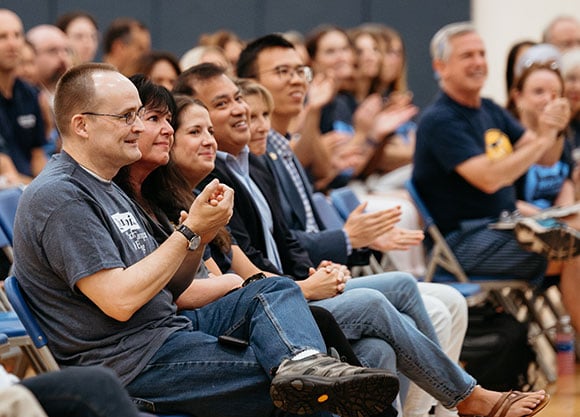
Convocation celebrates President Olian, Center for Excellence honorees and the future
August 23, 2024

August 23, 2024

“I’ve made a difficult personal decision to step down from my role as president next summer at the end of this academic year,” Olian told hundreds of faculty and staff, pausing mid-sentence to collect her next truth. “I’ve been so proud to be part of Quinnipiac University and all we stand for. It has truly been the privilege of my life.”
It was a memorable page in Quinnipiac’s 95th academic calendar, a Convocation that highlighted the accomplishments of the past year, the many opportunities that lie ahead, and the continued evolution the University of the Future. This year’s ceremony also included a welcome address by Provost Debra Liebowitz and remarks by Chief Experience Officer Tom Ellett.
“Over the past year, we’ve seen some major accomplishments thanks to the collective efforts of you, our fabulous faculty and staff, and of our students and alumni,” Olian said to begin the ceremony. “Our board has led the way in their willingness to support the forward-looking investments and initiatives that we’ve brought them.”
As she spoke about the excellence within Quinnipiac’s own family, Olian announced the 2024 Center for Excellence honorees below:
Honorees For Excellence in Service to Students
Elizabeth Beaton, associate director of financial aid
Robert Joven, university librarian
Tina Monteiro, manager of employee services in human resources
Honorees For Excellence in Teaching
Grant “Bobby” Crawford, professor of mechanical engineering, School of Computing and Engineering
Hilary Fussell Sisco, professor of public relations, School of Communications
Patricia Norberg, professor of marketing, School of Business
Olian also welcomed 34 new faculty members and 121 staff members, including Nadine Barnett Cosby, dean of the School of Communications; Brian Gallini, dean of the School of Law; and Jeff McCubbin, interim dean of the School of Health Sciences.
Over the past year, Quinnipiac has double-downed on its commitment to equity and inclusion, the national visibility of Quinnipiac, and a new model of living and learning.
“Last year, Vice President Bethany Zemba from my office and Vice President David Fryson sponsored the Critical Conversations Series,” Olian said, “as a learning foundation to hear views divergent from our own, to expand our own world view and to develop a constructive approach to listening — respectfully — across differences. I attribute some of the tolerance and calm that we experienced during the spring to these foundational values.”
The trajectory of Quinnipiac’s national visibility also rose with its participation in The Conversation, an independent news source that QU partnered with in January.
“So far, 13 different faculty members have authored 20 pieces resulting in approximately 430,000 reads globally,” Olian said. “We have also increased the frequency of the QU Poll for this election season, garnering significant attention for the university.”
Most recently, Quinnipiac unveiled its new 415-bed residence hall, The Grove, to promote a multi-cohort model of residents, including first-year students and sophomore, junior and senior mentors. The Grove also has a faculty member in residence.
“We’re intentionally blurring the lines between living and learning to advance both intellectual and emotional growth through this new residential model,” Olian said, adding that two other buildings on the South Quad — The Site and the new business school — will be completed in May.
“We owe much gratitude to our Board of Trustees that made a gutsy decision in the midst of COVID to go forward with the three South Quad buildings as enablers of our students’ learning and personal development, and as spaces that stimulate faculty research and creative pedagogy,” Olian said.
Olian also addressed the upcoming presidential election as a learning opportunity and a means to stay true to the university’s values. While she conceded the election could potentially be divisive, it doesn’t have to be that way.
“This is precisely where we need to remember our foundational values as a university and as a microcosm of society,” Olian said. “I think we all recognize that we will be around members of our own community and other communities where there are strong opposing viewpoints.
“Yes — in civilized societies people often disagree with you — nicely, even vociferously,” Olian added. “We prefer that such expression is not offensive, but it can be — we don’t encourage it even if we tolerate it — as long as those opposing expressions are respectful of others’ dignity, humanity and do not restrict others’ safety or freedom of expression.”
The best solution, Olian said, is for everyone to express their individual views by voting.
“When I think about the election this fall and what it can mean for QU, I see an opportunity for us to transform a potentially difficult period into an instructive and shining moment for our university,” Olian said. “We’ve now heard from some parents who say they’re attracted to Quinnipiac because we’re not a battleground, we’re inclusive and respectful.”
Another one of Olian’s priorities is to develop clarity around the distinctions of Quinnipiac, which include leveraging artificial intelligence in pedagogy, curricula and operation; continuing to deliver market-driven preparedness and the healthcare workforce of tomorrow; and developing the whole person.
Olian said 70 percent of graduates think generative AI should be incorporated into courses and more than half felt unprepared for the workforce, according to Inside Higher Ed.
“We already have some (AI) pilot projects underway, projects launched at the initiative of enterprising faculty or staff members,” Olian said. “Obviously, there are important governance and privacy issues that must be vetted with each application, but we should embrace the future with an open mind and a thirst for experimentation.”
It’s the same strategy with developing the workforce of the future.
“We see one distinction of Quinnipiac as its capacity to deliver market-driven career preparedness, whether through immersive, experiential, interdisciplinary learning or internships — all of these have a longstanding home here at Quinnipiac and can be developed further,” Olian said.
Case in point: More than 98 percent of QU’s graduates are employed or pursing advanced education within six months after getting their degrees. What’s more, Quinnipiac produces more healthcare professionals in Connecticut than any other university in the state.
“We pride ourselves not only on graduating students who are intellectually and career ready, but also on graduating students who are emotionally, life and future ready,” Olian said. “Our Recreation and Wellness Center is the centerpiece of our commitment to the well-being of the whole person. Our Living-Learning Communities play a huge role, too, in developing the whole person, and we’re about to expand that approach with the opening of The Grove.”
For Liebowitz, the upcoming year is filled with a vision for even more collaborative success among faculty and staff.
“We’re headed into another fantastic year. I am nothing but excited about the path we are on,” Liebowitz said. “It is one where we will continue, I have no doubt, with all of your work together. With collaboration, we will strengthen and lengthen the path we’re building together.
“We must continue to embrace and amplify the kinds of cross-unit collaborations, the creative and bold thinking that characterizes QU and has brought us to this point,” Liebowitz added. “And by doing so, we’ll be able to create learning environments and opportunities for our students and a place to work where our faculty and staff thrive.”
Ellett said this year’s incoming class of 1,947 new first-year students is 102 more than last year. The class also includes 213 transfer students.
Of the 2,160 students in the undergraduate Class of 2028, 32 percent are from Connecticut, 23 percent are from New York and 18 percent are from Massachusetts. Overall, this year’s incoming class comes from 31 states and 25 countries, Ellett said.
By school, 26 percent are enrolled in the School of Business, 24 percent are enrolled in the College of Arts and Sciences, 23 percent are enrolled in the School of Health Sciences, 10 percent are enrolled in the School of Nursing, 9 percent are enrolled in the School of Communications and 8 percent are enrolled in the School of Computing and Engineering.
“Thank you to all of the faculty and staff who have rolled up their sleeves this week and helped welcome our newest students at move-in,” Ellett said. “It was an invigorating experience — and I am grateful for all of the time our volunteers have dedicated to helping our newest Bobcats feel the support of our Bobcat community the moment they pulled onto our beautiful Mount Carmel Campus!”
Among Quinnipiac’s new graduate class, there are 1,186 students, which is 10 percent higher than last year, with 65 percent studying on campus and 35 percent studying online.
Get the latest news and events sent right to your email by subscribing to Quinnipiac Today.
Subscribe